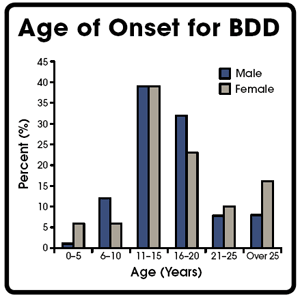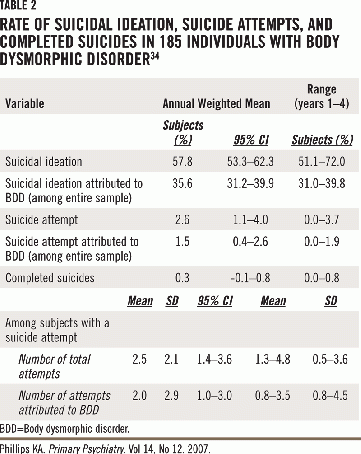Body Dysmorphic Disorder
Original Editors - Sean Beard & Jimmy Crick from Bellarmine University's Pathophysiology of Complex Patient Problems project.
Top Contributors - Sean Beard, James Crick, Rucha Gadgil, Kalyani Yajnanarayan, Elaine Lonnemann, Kim Jackson, 127.0.0.1, Wendy Walker, WikiSysop and Amanda Ager
Definition/Description[edit | edit source]
Body dysmorphic disorder (BDD) is a disorder characterized by extreme preoccupation with appearance that causes an individual personal distress in the presence of minimal or no physical defects. BDD is commonly considered to be an obsessive-compulsive spectrum disorder based on distinct similarities it shares with obsessive-compulsive disorder. Often, persons with BDD present first to dermatologists and/or plastic surgeons but necessitate referral to a psychiatrist or psychologist. Currently this disorder is classified as a somatoform disorder (a specific mental illness), but may also fall under the heading of an anxiety disorder. [1][2][3]
BDD is notable in that persons are concerned with a specific body part, rather than their entire body, which may help differentiate them from a person suffering from an eating disorder. [4]
First described as dysmorphophobia in 1886 in the European medical literature, it has since been described under several names which include: dermatologic hypochondriasis, beauty hypochondria, dermatologic nondisease, primary monosymptomatic hypochondriacal psychosis. [3]
Prevalence [edit | edit source]
BDD effects approximately 0.7% to 2.4% of general population. Specifically in the United States, 2.2% of men and 2.5% of women suffer from BDD.[6] Typically patients notice symptoms during adolescence, on average at the age of sixteen years. In spite of early onset of disease, most afflicted persons defer seeking treatment until their early thirties. BDD seems to affect men and women equally, however some studies report a slightly higher frequency in women.[1] Increased prevelance of BDD is seen in dermatological and cosmetic surgery practices.[3]
Characteristics/Clinical Presentation [1][2][3][4][8][edit | edit source]
Most common bodily areas of preoccupation include:
- skin: scarring, color, acne, wrinkles
- hair: going bald, excessive facial or body hair
- facial features: nose, eyelids
- breast: size, shape
- muscle: "muscle dysmorphia"
- body height/weight
- penis: "Koro" is a traditional Chinese misconception that the penis is shrinking[3]
- thighs
- buttocks
- body odor
People that suffer from BDD have a preoccupation with 5-7 distinct body parts.[9] Men most commonly ascribe defects to their height, hair, body proportion, and genitals. Women are more likely to report concerns with their hips, thighs, buttocks, legs, breast, and body weight. Obvious outward habits with people with BDD include compulsive behaviors such as:
- constant seeking or avoidance of reflection in windows, mirrors, spoons
- excessive grooming, or attempts to camouflage dress
- overuse of diet and exercise
- nervous tendancy to pick at skin imperfections
- comparing oneself to others
- repeated measuring or touching of perceived defect
In extreme cases of BDD, people may resort to:
- self-mutilation
- social isolation
- substance abuse
- seeking surgical intervention through self or professionally
Social manifestations of BDD may include:
- overreliance on positive feedback from partner, parent, spouse, friend, etc.
- decreased work and/or school performance and/or attendance.
- maintaining interpersonal relationships becomes strained or impossible.
Associated Co-morbidities[edit | edit source]
BDD is commonly associated with other co-morbid conditions, such as:
- Major depression: greater that 75% suffer from depression in a lifetime, making this the most commone co-morbid condition.[10]
- Anxiety: greater than 60% of people will experience this disorder along with BDD.[10]
- Obsessive compulsive disorders: 30 to 78% of people with BDD will have this, specifically hypochondriasis and trichotillomania[10]
- Substance abuse: 25-30%, with alcohol being the most commonly associated factor.[10]
- Social phobia: 38% of people with BDD will have this within the lifespan. Often this will manifest before the onset of BD. [10]
- Eating disorders: Anorexia and bulimia are relatively common.[10]
- Personality disorders: including paranoia and personality dependent disorders.[10]
- Suicide: 58-80% of people with BDD experience suicidal thoughts, and 3-25% have attempted to end their life.[9][11]
Medications[edit | edit source]
Selective Serotonin Reuptake Inhibitors (SSRI) may help alleviate the symptom severity, and is the current medication of choice for treating BDD. There is some evidence that SSRI's are more effective than non-SSRI's in terms of pharmacological treatment. Additionally, SSRI's are frequently used in treatment of many of the co-morbid conditions associated with BDD, including depression, social phobia, bulimia, hypochondriasis, and anxiety. In the United States, the most common brand names of SSRI's are Celexa, Lexapro, Prozac, Zoloft, Luvox, Paxil, and Anafranil. Though SSRI's have been well studied for the treatment of BDD, there are currently no FDA approved pharmacologic interventions for this disorder.[2][12]
SSRI's can be used in conjunction with non-pharmacologic therapy (such as cognitive behavioral therapy). Caution must be taken when discontinuing an SSRI abruptly.[12]
Other pharmacologic treatment options for BDD include anti-psychotics, benzodiazepines, lithium, serotonin-norepinephrine re-uptake inhibitors (SNRI), anti-epileptics, monoamine oxidase inhibitors (MAOI), and tricyclic antidepressants (TCA). These medications have only been studied in small trials, with a result of TCA's and SNRI's demonstrating the greatest potential.[3]
Diagnostic Tests/Lab Tests/Lab Values[edit | edit source]
There are currently 3 diagnostic criteria for BDD:[13]
- A preoccupation with an imagined or slight defect in appearance
- marked distress or impairment in social, occupational, or other areas of functioning resulting from the appearance preoccupation
- the preoccupation is not attributable to the presence of another psychiatric disorder
Diagnosis is difficult because of the accompaning shame that goes along with BDD, making a person with BDD reluctant to seek medical attention. More frequently plastic surgeons or dermatologists may suspect such a disorder based on frequent complaints and seeking surgical intervention. If a healthcare practitioner suspects BDD, then a referral to a psychiatrist or psychologist is recommended and should be followed through by the patient.[1][4]
Etiology/Causes[edit | edit source]
Multifactorial contributions are thought to play a role in the development in BDD, and they include:[1][8]
- neurobiological: there is some evidence to suggest a genetic component related to BDD. Studies have estimated that approximately 20% of BDD sufferers have a first degree relative with the disorder.[8] Other hypothesis have theorized an abnormal release and uptake of serotonin and dopamine, inflammatory processes interfering with serotonin production, and brain asymmetries of the caudate nucleus, or injury to the frontotemporal region.
- psychological factors: "psychoanalytic explanations suggest that body dysmorphic disorder arises from an unconscious displacement of sexual or emotional conflist, or feelings of inferiority, guilt, or poor self image on to a body part."[14] A cognitive behavioral therapeutic approach suggests that emotional, cognitive, and behavioral factors combine to produce this disorder. Cognitive factors include an unrealistic perfect body image, emphasis on attention to perceived defect, or a misinterpretation of others responses to their perceived defect. Behavioral factors are thought to stem from positive or negative reinforcment of certain physical characteristics, and is related to social learning.
- sociocultural factors: physical and psychological changes due to reinforcement during adolescence (e.g. neglectful, rejecting, critical) may contribute to image dissatisfaction.[1] Traumatic life events such as physical or sexual abuse may predispose a person to developing BDD. Even seemingly benign forms of teasing, if chronic in nature, have been proposed as contributing factors to development of this disorder - up to 60% of people with BDD report this.[8]
Systemic Involvement[edit | edit source]
Systemic manifestations of the disease are associated primarily with the comorbid conditions, as listed above. In particular, depression has been correlated with many systemic disorders, including:[15]
- cardiovascular: chest pain, palpatations, tachycardia
- gastrointestional: irritable bowel syndrome, GERD, ulcers
- neurological: parasthesias, dizziness, memory lapses
- musculoskeletal: weakness, fatigue, chronic low back pain, fibromyalgia
- immune: autoimmunity, recurrent infections, environmental hypersensativities
- other: insomnia, headaches
Additionally, substance abuse may disrupt many organ systems, including:[15]
- liver
- kidneys
- heart
- pancreas
- skeletal
Eating disorders are known to have deleterious effects on entire body systems, and are unique to each specific case and disorder.
Medical Management (current best evidence) [1][3][8][edit | edit source]
As outlined above, pharmacologic intervention is almost always utilized for the treatment of BDD despite the limited studies proving it efficacy. In addition to pharmacological treatment, psychological intervention is warranted. Currently cognitive behavioral therapy (CBT) is considered the gold standard treatment with BDD.[8] CBT treatments may include elimination of body checking, cognitive techniques to modify thoughts, exposure to avoided situations, and coping mechanisms for their preoccupation. Ultimately the goal of CBT is to help the person to change their innacurate perception of their physical self, and to place less emphasis on their physical appearance. Metacognitive therapy, which seeks to modify how a person thinks, has recently been used with limited success in the treatment of BDD.[16]
In 2005, the United Kingdom added the NICE guidelines for treatment of BDD and OCD. These guidelines suggest a step-wise approach to treating these disorders. [17]
- mild disorders (recommend a guided self-help book)
- moderate disorders (SSRI or CBT)
- severe disorders (combination of SSRI and CBT)
Physical Therapy Management (current best evidence)[edit | edit source]
Persons with BDD are primarily treated by physicans, and thus, specific treatment for BDD falls outside the scope of physical therapy practice. It is crucial for physical therapists to be aware of BDD in patients, as it relates to patient education, interpersonal interaction, personal wellness, and quality of life. Physical therapists are often the healthcare practitioner with which patients may feel comfortable confiding in, due to the nature of the profession. Recognition of the potential for BDD and appropriate refferal is essential for physical therapy practice. Physical activity has been proven to provide positive psychological benefits, in addition to the physical wellness it provides, and thus may be an appropriate adjunct therapy for persons participating in traditional BDD therapy.
Alternative/Holistic Management (current best evidence)[edit | edit source]
At this time, studies have demonstrated no efficacy for the use of non-pharmacological and non-psychiatric treatment of BDD. [1] Other forms of treatment sought most often include dermatology and surgical repair of perceived defect. Surgery is not recommnended for the treatment of BDD, due to concerns that psychological dysfunction may project to another part of the body.[1][8]
One study determined 30% of surgeons surveyed consider BDD an absolute contraindication for surgery.[18]
Differential Diagnosis [15][edit | edit source]
- Major depressive disorder
- Anxiety
- Obsessive compulsive disorder
- Social phobia
- Eating disorders: Anorexia and bulimia
- Personality disorder
- Bipolar disorder
- Seasonal affective disorder
Case Reports/ Case Studies[edit | edit source]
add links to case studies here (case studies should be added on new pages using the case study template)
Resources
[edit | edit source]
Anxiety and Depression Association of America
Overcoming Body Image Problems Including Body Dysmorphic Disorder (book)
OCD-UK Body Dysmorphic Disorder
Recent Related Research (from Pubmed)[edit | edit source]
see tutorial on Adding PubMed Feed
Extension:RSS -- Error: Not a valid URL: addfeedhere|charset=UTF-8|short|max=10
References[edit | edit source]
see adding references tutorial.
- ↑ 1.0 1.1 1.2 1.3 1.4 1.5 1.6 1.7 1.8 Crerand CE, Franklin ME, Sarwer DB. Body dysmorphic disorder and cosmetic surgery. Plast Reconstr Surg. 2006;118(7):167e-80e.
- ↑ 2.0 2.1 2.2 Bjornsson AS, Didie ER, Phillips KA. Body dysmorphic disorder. Dialogues Clin Neurosci. 2010;12(2):221-32.
- ↑ 3.0 3.1 3.2 3.3 3.4 3.5 3.6 Gupta R, Huynh M, Ginsburg IH. Body dysmorphic disorder. Semin Cutan Med Surg. 2013;32(2):78-82.
- ↑ 4.0 4.1 4.2 WebMD: Mental Health Center. Body Dysmorphic Disorder. http://www.webmd.com/mental-health/mental-health-body-dysmorphic-disorder (accessed 3 March 2014).
- ↑ Onlymyhealth. Understanding Body Dysmorphic Disorder. http://www.google.com/imgres?imgurl=&imgrefurl=http%3A%2F%2Fwww.onlymyhealth.com%2Funderstanding-body-dysmorphic-disorder-1285581494&h=0&w=0&sz=1&tbnid=LZ67Cr1MthucwM&tbnh=240&tbnw=160&zoom=1&docid=3ZhrRNCJI4ZE0M&ei=rJwUU-HHO-GfyQG-8IDQDw&ved=0CAUQsCUoAQ (Accessed 3 March 2014).
- ↑ Koran LM, Abujaoude E, Large MD, Serpe RT. The prevalence of bodyfckLRdysmorphic disorder in the United States adult population. CNS Spectr.fckLR2008;13(4):316-322.
- ↑ Healthy vs Living. Body Image. https://mrkhealth.pbworks.com/w/page/64690414/Body%20Image%20-%20Aaron,%20Siddharth,%20Kyler,%20Ben (accessed 3 March 2014).
- ↑ 8.0 8.1 8.2 8.3 8.4 8.5 8.6 Ross J, Gowers S. Body dysmorphic disorder. Advances in Psychiatric Treatment. 17(2):142-149.
- ↑ 9.0 9.1 Phillips, K. A., Menard, W., Fay, C., et al. Demographic characteristics, phenomenology, comorbidity, and family history in 200 individuals with body dysmorphic disorder. Psychosomatics 46: 317, 2005.
- ↑ 10.0 10.1 10.2 10.3 10.4 10.5 10.6 Gunstad, J., and Phillips, K. A. Axis I comorbidity in bodyfckLRdysmorphic disorder. Compr. Psychiatry 44: 270, 2003.
- ↑ 11.0 11.1 Phillips KA. Suicidality in Body Dysmorphic Disorder. Prim psychiatry. 2007;14(12):58-66.
- ↑ 12.0 12.1 Phillips KA, Hollander E. Treating body dysmorphic disorder with medication: evidence, misconceptions, and a suggested approach. Body Image. 2008;5(1):13-27.
- ↑ American Psychiatric Association. Diagnostic and StatisticalfckLRManual of Mental Disorders, Fourth Edition, Text Revision.fckLRWashington, D.C.: American Psychiatric Association, 2000.
- ↑ Phillips, K. A. Body dysmorphic disorder: The distress of imagined ugliness. Am. J. Psychiatry 148: 1138, 1991.
- ↑ 15.0 15.1 15.2 Goodman CC, Snyder TE. Differential Diagnosis for Physical Therapists, Screening for Referral. Saunders; 2012.
- ↑ Rabiei M, Mulkens S, Kalantari M, et al. Metacognitive therapy for body dysmorphic disorder patients in Iran: acceptability and proof of concept. J Behav Ther Exp Psychiatry. 2012;43:724-729.
- ↑ National Collaborating Centre for Mental Health (UK). Obsessive-Compulsive Disorder: Core Interventions in the Treatment of Obsessive-Compulsive Disorder and Body Dysmorphic Disorder. Leicester (UK): British Psychological Society; 2006. (NICE Clinical Guidelines, No. 31.) Available from: http://www.ncbi.nlm.nih.gov/books/NBK56458/
- ↑ Sarwer, D. B. Awareness and identification of body dysmorphic disorder by aesthetic surgeons: Results of a survey of American Society for Aesthetic Plastic Surgery members. Aesthetic Surg. J. 22: 531, 2002.









